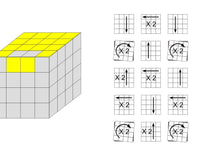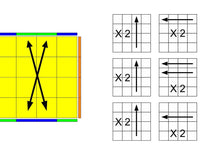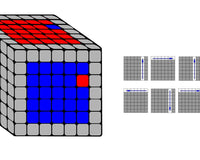A heads up - the blog this month is mainly directed towards newer cubers. I’m simply going to write up what I view as the main characteristics of speedcubes. I think this is a pretty exhaustive list, but there is also a lot of overlap between these terms, and to a large degree, they influence one another.
Weight: Different brands and models of speedcubes have different weights.
Size: The majority of standard 3x3 cubes are 57*57*57mm.
Turning speed: Firstly turning speed. You might be thinking, isn’t a good cube simply defined by how fast you can turn it? Well yes, for the most part, cubes that give you higher turns-per-second (tps) in your solves are better for you. However, this isn’t what this term describes – it is simply describing the ‘raw’ turning speed of the cube. Think of it as the amount the cube turns for a given applied force. To test turning speed, grab a cube and perform a strong flick of your right index finger on the top layer, and see how far it turns. The amount the layer rotates gives a good indicator of the raw turning speed –on most cubes the layer will turn somewhere between 90 and 360 degrees. There is a trade-off between turn speed and control.
Corner cutting: Corner cutting is probably the defining characteristic which sets apart speedcubes from ordinary Rubik’s brand or other storebought cubes. This is an extremely common term with which most speedcubers are familiar. It describes the degree to which the cube is able to accommodate misaligned layers in a solve. Good corner cutting enables moves to be made on the cube in a more fluid motion, as opposed to each move existing in isolation. For example, if you are able to turn the top layer only 60 degrees before beginning your next move on say, the right face, you will inevitably save time in your solves.
Reverse corner cutting: Reverse corner cutting is also an important feature of modern speedcubes. This is the tendency for a cube to be able to accommodate for misaligned layers, but in the opposite direction to standard corner cutting. The main example is the move R’. If a cube has enough reverse corner cutting ability, a slightly misaligned top layer in the clockwise direction will not cause an issue when performing R’. In general, speedcubes exhibit more corner cutting ability than reverse corner cutting, simply in nominal terms of the maximum offset angle which the cube can overcome.
Pops: Pops are every speedcuber’s nightmare – when pieces ‘pop’ out of the cube. For the most part, 3x3 cubes these days do not pop, and it is more prevalent on larger cubes such as the 6x6 and 7x7.
Corner twists: The ability for a single corner to twist in place whilst using the cube. This occurs infrequently, only on certain 3x3 cubes.
Lockups: Lockups occur when the cube ‘locks up’ or gets stuck whilst it is being turned. There are numerous reasons as to why this would happen during solves. For example, aggressive turning styles on loose cubes often result in lockups, as the cube is harder to control, and individual pieces are able to move around a lot. Cubes with poor corner cutting ability have a natural tendency to lock up, as even slightly inaccurate turns will mean that the cube doesn’t allow you to turn the next side that you would like to turn. Lockups are of course undesirable in a speedcube.
Feel: This is something that can be very difficult to describe, and you really have to experience it yourself to understand. Some adjectives to describe overall cube feel are words such as: Buttery, smooth, clicky, bumpy, etc. ‘Feel’ describes the physical sensation of a turn. A ‘smooth’ or ‘buttery’ cube will feel like two smooth surfaces gliding over one another. In comparison, a bumpy or clicky cube will feel like there are a lot of imperfections on the plastic between the pieces. This isn’t necessarily a bad thing, and in some cases, a bumpy cube helps deliver feedback to the user. Cubes vary on this scale between perfectly smooth, and very bumpy.
Stability: Generally most people want a cube that feels stable in their hands, and is very controllable in solves. A simple way to test stability of a cube is to simply shake it and see how much individual pieces rattle about. Instability can be mitigated by tensioning the cube tighter, but this can have trade-offs with regard to turning speed and corner cutting.
Variance/Predictability: This is something I’ve thrown in, and it might seem a bit abstract, but I see it as the tendency for random lockups of a cube – whether a cube performs reliably with a given turning style. For example, most 5x5 cubes are generally fine, but once in a while they’ll experience a really bad lockup, which you can never really see coming (otherwise you’d avoid it!). This term isn’t the frequency of lockups. A cube which locks up all the time consistently would be pretty predicable in this definition. A cube which is really good, but seems to have random, seemingly unexplainable lockups, would be unpredictable.
The need for ‘breaking in’: Some speedcubes are extremely good right out of the box, and to get used to and comfortable with the cube requires very little time or effort. Others can be pretty average brand new, but can improve markedly after re-tensioning, lubrication, and general use. So don’t be frustrated if your cube isn’t incredible as soon as you get it!
There are of course other minor differences between cubes, such as the specific shape and mold of the pieces, as well as the quality of the stock stickers.
I hope this was helpful!






1 comment
Philip
Although corner twists “occur infrequently, only on certain 3×3 cubes”, they sure can affect some solves, can’t they Feliks? Like, maybe a certain 5.33 DNF? :P